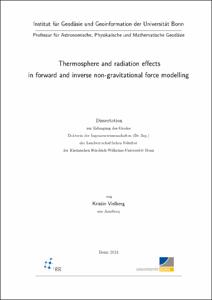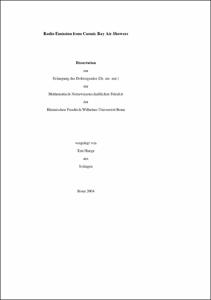Vielberg, Kristin: Thermosphere and radiation effects in forward and inverse non-gravitational force modelling. - Bonn, 2024. - Dissertation, Rheinische Friedrich-Wilhelms-Universität Bonn.
Online-Ausgabe in bonndoc: https://nbn-resolving.org/urn:nbn:de:hbz:5-74145
Online-Ausgabe in bonndoc: https://nbn-resolving.org/urn:nbn:de:hbz:5-74145
@phdthesis{handle:20.500.11811/11288,
urn: https://nbn-resolving.org/urn:nbn:de:hbz:5-74145,
doi: https://doi.org/10.48565/bonndoc-213,
author = {{Kristin Vielberg}},
title = {Thermosphere and radiation effects in forward and inverse non-gravitational force modelling},
school = {Rheinische Friedrich-Wilhelms-Universität Bonn},
year = 2024,
month = feb,
volume = Nr. 936,
note = {Precise non-gravitational satellite force models are crucial for various space-based applications, thus contributing to a better understanding of the Earth system.
Satellite orbits are perturbed by gravitational and non-gravitational forces. For satellites in low-Earth orbits, in addition to the dominant force due to atmospheric drag, the most important non-gravitational forces are related to the radiation of the Sun and the Earth. The electromagnetic solar radiation as well as the Earth’s outgoing radiation, consisting of emitted thermal radiation and the reflected sunlight, are either absorbed or reflected at the satellite’s surface. The resulting forces are known as Solar and Earth radiation pressure, respectively. The re-emission of the absorbed heat causes the thermal re-radiation pressure force. The modelling of the radiation pressure forces depends on measured fluxes as well as on the satellite’s mass, surface area and plate materials, of which especially the fluxes and material properties are known to introduce errors.
The aim of this thesis is to extend the existing radiation pressure force models, first, by detecting and overcoming systematic errors in the analytical formulations. In a second step, the extended model is applied in an inverse estimation approach to further improve remaining inconsistencies.
The extended radiation pressure force models are applied on satellites with simple shape, i.e., the Gravity Recovery And Climate Experiment (GRACE) satellites consisting of flat surfaces and on spherical Satellite Laser Ranging (SLR) satellites. The suggested extensions of the forward force modelling are validated carefully (1) by comparing the modelled forces to accelerometer measurements (for GRACE), and (2) by evaluating their impact on the satellite orbit based on residuals to SLR measurements (for GRACE and spherical satellites). The validation during the year 2008 revealed that a fine discretization (1°) of the Earth’s footprint leads to the largest improvements in the Earth radiation pressure force modelling, i.e., for GRACE the SLR residual root mean square (RMS) decreases by 38%. Choosing hourly radiation data together with angular dependency models additionally reduces the residual RMS by 2%. Furthermore, considering fitted heat-conductive thermal re-radiation for GRACE decreases the SLR residual RMS by 36% compared to using instantaneous re-radiation. The impact of the force model extensions on spherical SLR satellites is found to be generally smaller, which is related to their orbital altitude of more than 700 km.
The extended non-gravitational force models can be applied in an inverse approach, where an adjustment to measured forces allows for the estimation of selected parameters in the model to improve on the remaining inconsistencies. In the estimation of thermospheric neutral densities, this study found that extensions of the radiation pressure force modelling impact the neutral density by up to 5% depending on the solar activity. It is therefore likely that omissions caused by application of the standard models contribute to the differences between existing estimates. In a second example, first experiments to solve for radiation-related parameters based on extended radiation pressure force models are carried out. Here, the quality of the accelerometer calibration still limits the inverse estimations from GRACE data and finding a stable parametrization remains challenging. Estimating radiation pressure scale factors from SLR data reveals that Ajisai is a promising candidate to further the research on the adjustment of radiation-related parameters. All in all, the results are encouraging to determine physical radiation pressure model parameters from satellite accelerometry and SLR data in the future in order to enable the retrieval of a geodetic Earth’s energy imbalance estimate.},
url = {https://hdl.handle.net/20.500.11811/11288}
}
urn: https://nbn-resolving.org/urn:nbn:de:hbz:5-74145,
doi: https://doi.org/10.48565/bonndoc-213,
author = {{Kristin Vielberg}},
title = {Thermosphere and radiation effects in forward and inverse non-gravitational force modelling},
school = {Rheinische Friedrich-Wilhelms-Universität Bonn},
year = 2024,
month = feb,
volume = Nr. 936,
note = {Precise non-gravitational satellite force models are crucial for various space-based applications, thus contributing to a better understanding of the Earth system.
Satellite orbits are perturbed by gravitational and non-gravitational forces. For satellites in low-Earth orbits, in addition to the dominant force due to atmospheric drag, the most important non-gravitational forces are related to the radiation of the Sun and the Earth. The electromagnetic solar radiation as well as the Earth’s outgoing radiation, consisting of emitted thermal radiation and the reflected sunlight, are either absorbed or reflected at the satellite’s surface. The resulting forces are known as Solar and Earth radiation pressure, respectively. The re-emission of the absorbed heat causes the thermal re-radiation pressure force. The modelling of the radiation pressure forces depends on measured fluxes as well as on the satellite’s mass, surface area and plate materials, of which especially the fluxes and material properties are known to introduce errors.
The aim of this thesis is to extend the existing radiation pressure force models, first, by detecting and overcoming systematic errors in the analytical formulations. In a second step, the extended model is applied in an inverse estimation approach to further improve remaining inconsistencies.
The extended radiation pressure force models are applied on satellites with simple shape, i.e., the Gravity Recovery And Climate Experiment (GRACE) satellites consisting of flat surfaces and on spherical Satellite Laser Ranging (SLR) satellites. The suggested extensions of the forward force modelling are validated carefully (1) by comparing the modelled forces to accelerometer measurements (for GRACE), and (2) by evaluating their impact on the satellite orbit based on residuals to SLR measurements (for GRACE and spherical satellites). The validation during the year 2008 revealed that a fine discretization (1°) of the Earth’s footprint leads to the largest improvements in the Earth radiation pressure force modelling, i.e., for GRACE the SLR residual root mean square (RMS) decreases by 38%. Choosing hourly radiation data together with angular dependency models additionally reduces the residual RMS by 2%. Furthermore, considering fitted heat-conductive thermal re-radiation for GRACE decreases the SLR residual RMS by 36% compared to using instantaneous re-radiation. The impact of the force model extensions on spherical SLR satellites is found to be generally smaller, which is related to their orbital altitude of more than 700 km.
The extended non-gravitational force models can be applied in an inverse approach, where an adjustment to measured forces allows for the estimation of selected parameters in the model to improve on the remaining inconsistencies. In the estimation of thermospheric neutral densities, this study found that extensions of the radiation pressure force modelling impact the neutral density by up to 5% depending on the solar activity. It is therefore likely that omissions caused by application of the standard models contribute to the differences between existing estimates. In a second example, first experiments to solve for radiation-related parameters based on extended radiation pressure force models are carried out. Here, the quality of the accelerometer calibration still limits the inverse estimations from GRACE data and finding a stable parametrization remains challenging. Estimating radiation pressure scale factors from SLR data reveals that Ajisai is a promising candidate to further the research on the adjustment of radiation-related parameters. All in all, the results are encouraging to determine physical radiation pressure model parameters from satellite accelerometry and SLR data in the future in order to enable the retrieval of a geodetic Earth’s energy imbalance estimate.},
url = {https://hdl.handle.net/20.500.11811/11288}
}









